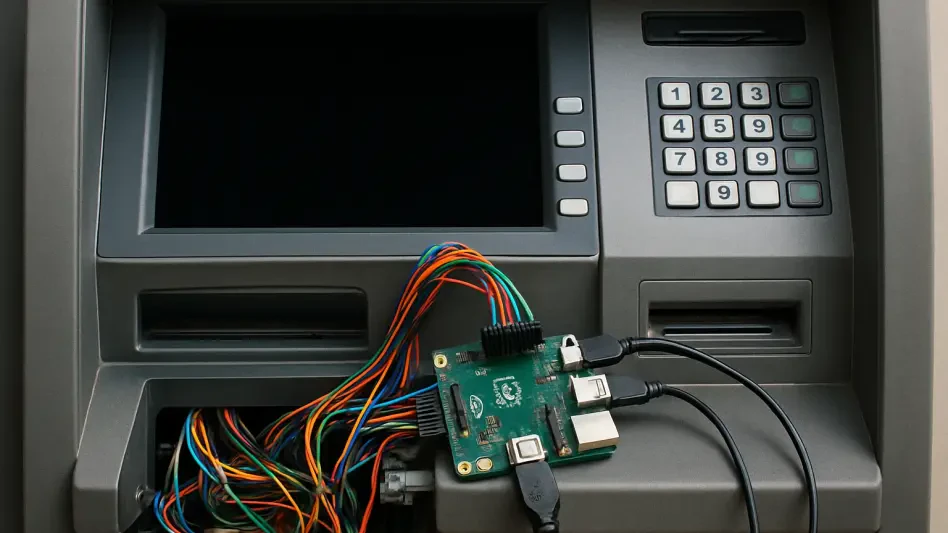Imagine a scenario where a small, seemingly innocuous device, often used by hobbyists for DIY projects, becomes a gateway for cybercriminals to infiltrate a bank’s ATM network, exposing critical vulnerabilities. This is not a hypothetical situation but a chilling reality uncovered in a sophisticated cyberattack orchestrated by the threat group UNC2891. Their weapon of choice? A Raspberry Pi, a compact and affordable single-board computer, transformed into a covert backdoor to bypass traditional security measures. This incident highlights a critical vulnerability at the intersection of physical and digital security in financial infrastructure, raising urgent questions about the adequacy of current defenses against evolving cyber threats.
The significance of this attack lies in its demonstration of how everyday technology can be weaponized with devastating precision. By leveraging a Raspberry Pi, attackers gained unauthorized access to a bank’s internal systems, exposing gaps in both technological safeguards and physical security protocols. This review delves into the mechanics of this breach, evaluating the performance and features of the Raspberry Pi as a tool for cybercrime, while exploring the broader implications for financial institutions facing hybrid threats.
Technical Analysis of the Raspberry Pi Backdoor
Physical Deployment and Network Intrusion
The ingenuity of this attack began with physical access to an ATM environment, where attackers connected a Raspberry Pi equipped with a 4G modem to a network switch linked directly to the ATM. This setup enabled remote access to the bank’s internal systems, effectively sidestepping conventional perimeter defenses such as firewalls. The use of a Raspberry Pi in this context showcases its versatility as a low-cost, portable device capable of acting as a persistent entry point into highly secured networks.
What makes this deployment particularly alarming is the ease with which it was executed. The Raspberry Pi, small enough to remain unnoticed in a server room or ATM enclosure, provided a stable platform for continuous communication with external command-and-control servers. This physical-digital bridge underscores a critical oversight in securing hardware access points, revealing how a device costing less than $50 can undermine multi-million-dollar security investments.
Stealth Mechanisms with Custom Malware
Central to the attack was the implementation of a custom backdoor named TINYSHELL, designed to maintain persistent communication through a dynamic DNS domain. This malware exhibited remarkable stealth by masquerading as a legitimate system process called “lightdm,” while operating from unconventional directories like /tmp and /var/snap/.snapd. Such tactics made it nearly invisible to routine security scans, highlighting the Raspberry Pi’s role as an enabler of sophisticated concealment strategies.
Further enhancing its evasiveness, TINYSHELL exploited Linux bind mounts—a technique associated with MITRE ATT&CK ID T1564.013—to hide its presence from standard forensic tools. This level of obfuscation demonstrates how the Raspberry Pi, paired with tailored malware, can serve as a formidable tool for attackers aiming to maintain long-term access without detection. The ability to run such complex operations on a minimal hardware footprint is both a testament to the device’s capability and a warning of its potential misuse.
Advanced Manipulation via Rootkit Integration
The attack escalated with the deployment of a rootkit named CAKETAP on the ATM switching server, aimed at manipulating hardware security modules by spoofing authorization responses. Facilitated by the Raspberry Pi’s persistent network access, this rootkit positioned attackers to potentially execute fraudulent ATM withdrawals. The precision of this approach indicates a deep understanding of banking systems, with the Raspberry Pi acting as the linchpin for delivering and sustaining such advanced threats.
This component of the attack reveals the device’s capacity to support highly specialized malware operations. By serving as a stable relay point, the Raspberry Pi enabled attackers to pivot within the network, using the bank’s monitoring server for lateral movement and even exploiting the mail server as an additional access channel. This multi-layered exploitation underscores the device’s effectiveness in facilitating complex cyber operations far beyond its intended educational or hobbyist purposes.
Emerging Patterns in Cybercrime Technology
The use of a Raspberry Pi in this ATM backdoor attack reflects a broader trend of cybercriminals adopting low-cost, widely available hardware for high-stakes operations. Financial institutions are increasingly targeted by hybrid attacks that blend physical intrusion with digital exploitation, leveraging devices like the Raspberry Pi to bypass traditional security perimeters. This incident signals a shift toward more resourceful threat actors who exploit the accessibility of such technology to achieve their goals.
Moreover, the attack highlights the growing reliance on obscure Linux features and memory-resident malware to evade detection. Cybersecurity experts note a consensus that conventional defenses, focused on network boundaries, fall short against these integrated threats. The Raspberry Pi’s role in this context is a stark reminder of how everyday tools can be repurposed into instruments of significant disruption when paired with advanced malicious software.
Implications and Challenges for Financial Security
The implications of this breach extend far beyond a single bank, exposing systemic risks to critical financial infrastructure. The Raspberry Pi’s successful deployment as a backdoor device illustrates the potential for widespread unauthorized access, which could lead to substantial financial losses if not addressed. This incident serves as a wake-up call for institutions to reassess their vulnerability to physical tampering and the integration of unassuming hardware into their networks.
Detecting and mitigating such attacks pose significant challenges, particularly due to the use of anti-forensic techniques and memory-resident malware. Current security postures often overlook physical access controls to infrastructure like switch ports and ATM-connected systems, leaving exploitable gaps. Recommendations from cybersecurity specialists include enhanced monitoring of system calls using tools like auditd or eBPF, and stricter controls on binaries in risky directories, emphasizing the need for a holistic approach to counter devices like the Raspberry Pi in malicious hands.
Verdict on the Raspberry Pi as a Cyber Threat Tool
Reflecting on this alarming incident, it becomes evident that the Raspberry Pi, while a brilliant innovation for education and experimentation, has been effectively weaponized into a potent cyber threat tool by UNC2891. Its low cost, portability, and compatibility with advanced malware make it an ideal choice for establishing a covert backdoor into a bank’s ATM network. The stealth and persistence it enabled through custom tools like TINYSHELL and CAKETAP are particularly concerning, exposing critical weaknesses in financial security frameworks.
Moving forward, financial institutions must prioritize securing physical access points and integrating advanced monitoring to detect anomalies facilitated by such devices. Adopting strategies like capturing memory images during incident response and scrutinizing unusual system behaviors can help uncover hidden threats. As cybercriminals continue to innovate, the industry must stay ahead by developing multi-layered defenses that address both the technological prowess and the deceptive simplicity of tools like the Raspberry Pi, ensuring that future breaches are prevented before they escalate.








